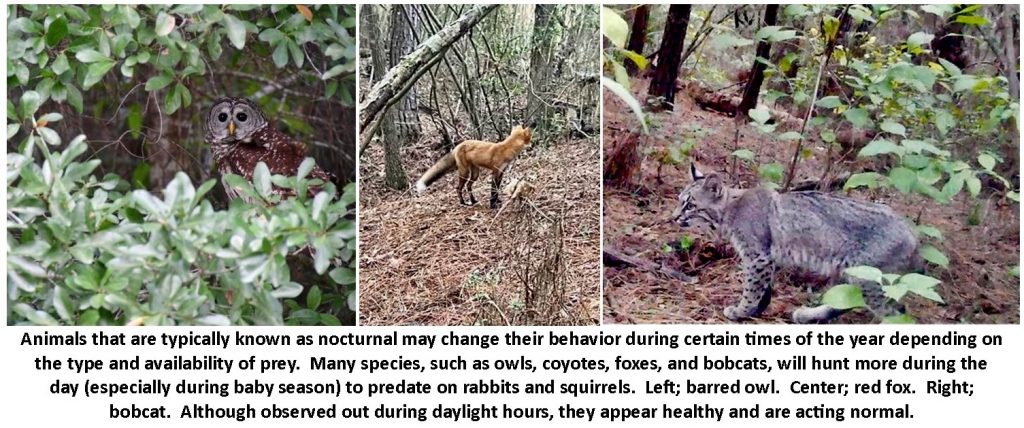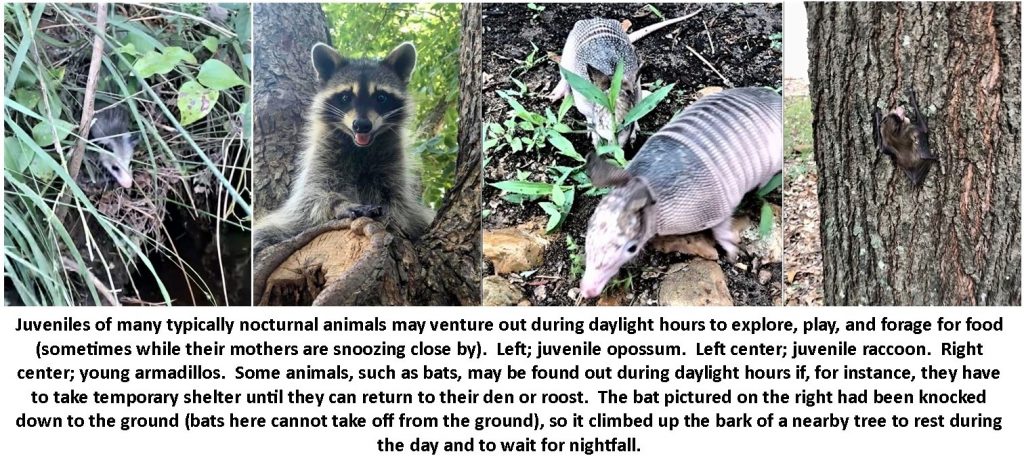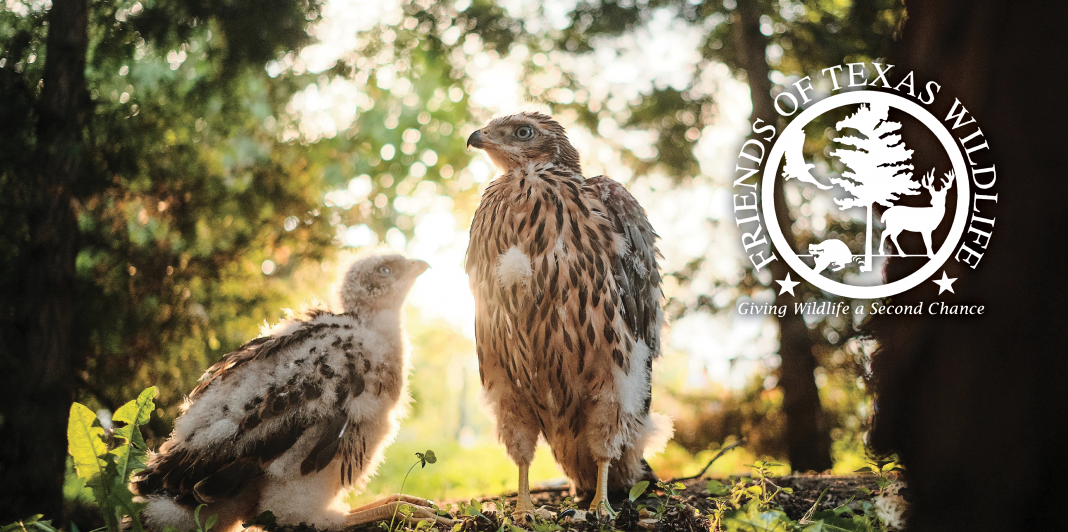Why Does My Night Owl Think It’s an Early Bird?
We’ve all heard the expressions “night owl” and “early bird”. Most of the wildlife animals living in our area, especially the mammals, are nocturnal, meaning they are active mainly after dark. We expect raccoons, skunks, opossums, and the like to be scurrying around at night; however, these animals are sometimes observed out during daylight hours. Many people call our wildlife center afraid that normally nocturnal animals observed out during the day must be sick, but that is often not the reason. This month’s article will give a little insight as to why this may occur.
One of the main reasons normally nocturnal animals may be seen during the day is because they have young to feed. This is true for both mammals and birds of prey such as owls. Nursing animal mothers will often search for food during daylight hours when there is less competition from other animals (since she is responsible for her young, she does not want to risk getting into a fight over food). Nursing moms also have increased nutritional needs, requiring the intake of more calories than usual, so moms may venture out several times in a 24-hour period in search of something to eat. In the case of owls, they generally have multiple young to feed, so they may need to supplement their food with hunting during the day as well as night. Both the male and female will hunt and bring prey back to their fast-growing owlets. For some animals, such as raccoons and opossums, their young are quite dependent on them for several months, and great horned owls stay together as a family unit for as many as eight months. When you consider multiple mouths to feed stretched over a period of months, you can see why sometimes it may be necessary to search for food during daylight hours when more and different types of food or prey may be easily available. One example of this would be with coyotes, bobcats, and foxes; they are generally most active at night, but especially during baby season a portion of their diet consists of squirrels and rabbits. In those instances, observing a coyote, bobcat, or fox out during daylight hours may simply mean they are in pursuit of diurnal prey.

Likewise, juvenile animals may be more likely to be out and foraging for food during the day. In some species, such as raccoons, young animals do not become predominantly nocturnal until they are closer to one year old. Again, this is because there may be less competition for food during daylight hours, especially if they have not yet established territories of their own. Youngsters that are still dependent on their mothers may be observed exploring during the day (think of them as wildlife juvenile delinquents) even though mom might well be sleeping somewhere very close by. This is likely to occur during late spring and summer months.
Another reason a nocturnal animal might be seen during daylight hours would be if they were stressed or displaced for some reason. For example, opossums lose consciousness (“playing possum”) when they are scared or threatened. It can take them up to sixty minutes to completely return to a conscious state. They and other animals may simply be too frightened to move from where they are during daylight hours, and they might simply hunker down wherever they are to wait for nightfall. Likewise, in the case of extremely inclement weather (especially flooding rains), animals may have to flee their den or hiding spot to get to higher or safer ground. It is common during periods or heavy rains for people to find baby skunks, armadillos, raccoons, or rabbits (animals that would typically be living in a burrow). If their den or burrow suddenly begins to flood, the mom will have to move her babies one at a time to a safer location. At times that may mean she simply places the babies on high ground, somewhat out in the open, while she searches for a new den. Given time, she will generally return to retrieve her babies one at a time and travel with them to her new den. Although we seldom get extreme cold weather here, that could also be another reason for seeing animals out during the day; they are simply looking for nutrition when the temperature is a bit more moderate.
 People can also impact the behavior of wildlife. For example, urbanization may cause nocturnal animals to change their behavior. For example, in areas where people feed pets outside, wildlife animals might be drawn in to steal cat or dog food whenever it’s available; who doesn’t enjoy a free meal? Other human impacts that can displace wildlife would include construction/home renovation projects; tree removal; burning of brush piles; and interactions between domestic pets and wildlife animals. A wildlife animal that is suddenly evicted from a burrow, den, or other hiding place will bolt and take temporary shelter wherever they can and hunker down until it is nightfall once again. In these instances, please be patient and give the animal(s) time to find new shelter.
People can also impact the behavior of wildlife. For example, urbanization may cause nocturnal animals to change their behavior. For example, in areas where people feed pets outside, wildlife animals might be drawn in to steal cat or dog food whenever it’s available; who doesn’t enjoy a free meal? Other human impacts that can displace wildlife would include construction/home renovation projects; tree removal; burning of brush piles; and interactions between domestic pets and wildlife animals. A wildlife animal that is suddenly evicted from a burrow, den, or other hiding place will bolt and take temporary shelter wherever they can and hunker down until it is nightfall once again. In these instances, please be patient and give the animal(s) time to find new shelter.
While the initial reaction might be concern over seeing normally nocturnal animals out during the day, there are many reasons why that might occur. Simply observing them out and about should not necessarily raise any alarms. To coin a phrase, “they may have babies, not rabies”. The time of day should not be the only factor considered. Healthy animals will have a healthy general appearance with clear eyes and good overall body condition, and their movements should be fluid. Sick animals will generally appear underweight, their coats may be sparce or matted (appearing ungroomed), they may tremble, stumble, or be unable to climb. Other indications of illness would be circling, remaining motionless for hours in an exposed location, or being non-reactive to noise or visual cues (as in you are able to get very close without the animal attempting to run away). Bear in mind these indications refer to adult animals; baby or very young animals may react quite differently as they have not yet necessarily learned to be wary of humans or domestic animals. If you are unsure if what you observe is normal behavior or cause for concern, please call a rehabber or local rescue center for advice and guidance.
To learn more about what we do and view pictures of many of the animals we assist, please visit our Facebook page at www.facebook.com/SavingTexasWildlife. Details and specifies-specific flowcharts regarding how to help found animals can be viewed on our website at www.ftwl.org (click on “Help and Advice”). These charts are extremely helpful to determine if an animal truly needs rescuing or not. If you need assistance with a wildlife animal you have found, please call us at 281-259-0039 or email us at [email protected]. We offer many educational programs (including camps, birthday parties, educational presentations, and Second Saturdays). Our educational visitor’s center is open the second Saturday of each month from 10 a.m. to 2 p.m., located at 29816 Dobbin Hufsmith Road, Magnolia, Texas, so the next one will be Saturday, January 8 ($5 per person, kids 3 and under are free). If you are interested in becoming a licensed wildlife rehabilitator, we will be hosting the International Wildlife Rehabilitation Council’s Basic Wildlife Rehabilitation class in early 2022. This will be an in-person, two-day class held at our education center. If you are interested in attending this class, please email us at [email protected].















